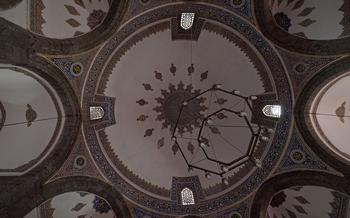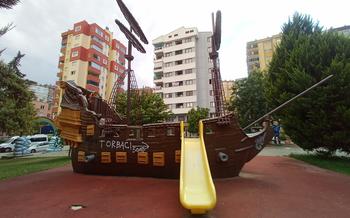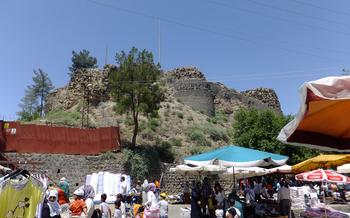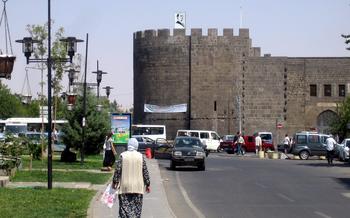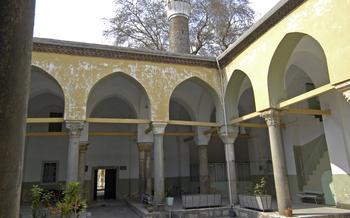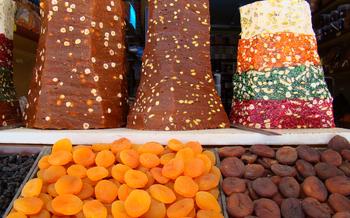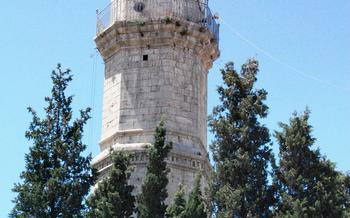
Shafi'i Mosque
- A Journey to Diyarbakır's Architectural Gem: The Shafi'i Mosque
- History and significance of the mosque
- Architectural features and unique characteristics
- Location and how to get there
- Stepping into the Past: Unveiling the Mosque's History
- A Masterpiece of Islamic Architecture: Exploring the Mosque's Design
- A Place of Worship and Community: The Shafi'i Mosque's Function
- A Visual Feast: Admiring the Mosque's Interior
- A Symbol of Cultural Heritage: Preserving the Shafi'i Mosque
- A Journey Through Time: Walking Tour of the Mosque
- A Place of Tranquility: Finding Inner Peace at the Mosque
- Interacting with the Community: A Glimpse into Local Life
- A Culinary Adventure: Tasting Local Delights
- A Unique Souvenir: Shopping for Local Handicrafts
- A Photographer's Paradise: Capturing the Mosque's Beauty
- A Cultural Immersion: Attending Local Events
- Insider Tip: A Hidden Gem Nearby
A Journey to Diyarbakır's Architectural Gem: The Shafi'i Mosque
In the heart of Diyarbakır, a city steeped in history and culture, stands a magnificent architectural masterpiece that draws visitors from around the world: the Shafi'i Mosque. This iconic landmark, with its stunning Seljuk and Ottoman influences, is a testament to the city's rich Islamic heritage and architectural prowess. As you embark on a journey to Diyarbakır, let us guide you through the wonders of the Shafi'i Mosque, a true gem that will leave an indelible mark on your soul.
History and significance of the mosque
The Shafi'i Mosque, also known as the Ulu Cami (Grand Mosque), was commissioned by the Artuqid dynasty in the 12th century and completed in the 14th century. It holds a prominent position as one of the oldest and most significant mosques in Diyarbakır, serving as a religious and cultural center for centuries. The mosque's name, Shafi'i, is derived from the prominent Islamic legal school founded by Imam al-Shafi'i, highlighting its importance in the region's Islamic history.
Architectural features and unique characteristics
The Shafi'i Mosque showcases a harmonious blend of Seljuk and Ottoman architectural styles. Its imposing structure, adorned with intricate carvings and tilework, reflects the grandeur and artistry of Islamic architecture. The mosque's most striking feature is its towering minaret, which stands tall as a symbol of Diyarbakır's skyline. Inside, the mosque boasts a spacious prayer hall, adorned with elegant columns and arches, creating a sense of awe and serenity.
Location and how to get there
Situated in the historic district of Diyarbakır, the Shafi'i Mosque is easily accessible by foot or public transportation. To fully immerse yourself in the city's charm, we recommend exploring the surrounding streets, lined with traditional shops and cafes, before entering the mosque's courtyard. As you approach the mosque, take a moment to admire its impressive facade, a prelude to the architectural wonders that await you within.
Stepping into the Past: Unveiling the Mosque's History
The Shafi'i Mosque, a testament to the rich history of Diyarbakır, traces its origins back to the Artuqid dynasty, a prominent Islamic ruling family of the 12th century. Commissioned by Sultan Malik Salih, the mosque was completed in 1189, becoming a cornerstone of Islamic architecture and a symbol of Diyarbakır's cultural heritage.
In the annals of history, the Shafi'i Mosque played a pivotal role in the development of Islamic architecture, showcasing a harmonious blend of Seljuk and Ottoman styles. Its architectural innovations and intricate details earned it recognition as a masterpiece, inspiring future generations of architects and builders.
Throughout the centuries, the mosque witnessed numerous historical events and stories that shaped its significance. It served as a sanctuary for worship, learning, and community gatherings, leaving an indelible mark on the social and religious fabric of Diyarbakır.
A Masterpiece of Islamic Architecture: Exploring the Mosque's Design
The Shafi'i Mosque showcases a harmonious blend of Seljuk and Ottoman architectural styles. Its striking features include the pointed arches, intricate geometric patterns, and elegant calligraphy. The mosque's exterior is adorned with beautiful carvings and tilework, while the interior boasts a stunning mihrab (prayer niche) and minbar (pulpit). The mihrab is a masterpiece of Islamic art, featuring intricate tilework and Quranic inscriptions. The minbar is equally impressive, with its carved wooden panels and intricate designs.
The mosque's design reflects the rich history and cultural heritage of Diyarbakır. The pointed arches are reminiscent of the Seljuk period, while the tilework and calligraphy are influenced by the Ottoman era. The mosque's overall design is a testament to the skill and artistry of the craftsmen who built it.
Visitors to the Shafi'i Mosque are awed by its intricate details and symbolism. The mosque's design is not merely decorative; it also serves a functional purpose. The pointed arches, for example, help to support the weight of the roof, while the tilework and calligraphy provide insulation and protection from the elements.
The Shafi'i Mosque is a true masterpiece of Islamic architecture. Its unique design and intricate details make it a must-see for anyone interested in Islamic art and architecture.
A Place of Worship and Community: The Shafi'i Mosque's Function
The Shafi'i Mosque stands as a testament to the enduring significance of religious practices in Diyarbakır. As a center for Islamic worship, the mosque serves as a spiritual home for the local Muslim community, facilitating the five daily prayers and congregational gatherings. Devotees find solace and guidance within its walls, seeking spiritual enlightenment and connection with the divine.
Beyond its religious function, the Shafi'i Mosque has played a pivotal role in the development of the local community. Throughout history, it has served as a hub for social interaction, education, and community initiatives. Religious scholars and students have gathered within its premises to engage in theological discussions and disseminate knowledge. The mosque has also been instrumental in providing social support, offering assistance to those in need and fostering a sense of unity and belonging among its members.
In the past, the mosque served as a focal point for community events and celebrations. It hosted religious festivals, weddings, and other social gatherings, bringing people together to share in their traditions and strengthen their bonds. Today, the mosque continues to be an important part of the local community, preserving cultural heritage and contributing to the vibrant social fabric of Diyarbakır.
A Visual Feast: Admiring the Mosque's Interior
Stepping inside the Shafi'i Mosque is like stepping into a realm of intricate beauty and artistry. The mosque's interior is a testament to the skill and devotion of its builders, who left no surface untouched in their quest to create a masterpiece.
The stunning mihrab (prayer niche), the focal point of the mosque, is adorned with intricate tilework and calligraphy. Its graceful arch frames the qibla, the direction Muslims face during prayer, and serves as a reminder of the sacred nature of the space.
The minbar (pulpit), from which the imam delivers sermons and recitations, is another masterpiece of Islamic craftsmanship. Its intricate carvings and inlaid mother-of-pearl create a visually captivating display that draws the eye upwards.
The walls of the mosque are adorned with tilework in shades of blue, green, and turquoise, creating a vibrant tapestry of patterns and motifs. Each tile is meticulously placed, forming geometric designs and floral motifs that seem to dance before the eyes.
Calligraphy, the art of beautiful handwriting, plays a prominent role in the mosque's interior. Verses from the Quran and sayings of the Prophet Muhammad are inscribed in elegant Arabic script, adding a layer of spiritual meaning to the space.
The overall effect of the mosque's interior is one of awe and inspiration. Every detail, from the intricate tilework to the delicate calligraphy, contributes to the sense of sacredness and beauty that permeates the atmosphere.
A Symbol of Cultural Heritage: Preserving the Shafi'i Mosque
Preserving the Shafi'i Mosque: A Legacy of Cultural Heritage
The Shafi'i Mosque stands as a testament to the enduring spirit of cultural heritage, embodying the architectural achievements of past civilizations and the rich traditions of the local community. Its preservation is of paramount importance, not only for its historical significance but also for its role in fostering cultural identity and continuity.
Efforts to restore and maintain the mosque have been ongoing, with meticulous attention to detail to ensure that its original features and integrity are preserved. These efforts involve skilled artisans, historians, and architects who work tirelessly to safeguard the mosque's unique characteristics, from its intricate tilework to its awe-inspiring minarets.
Preserving the Shafi'i Mosque is not without its challenges. The passage of time, environmental factors, and the wear and tear of daily use can take a toll on the mosque's structure and decorative elements. Balancing the need for conservation with the mosque's ongoing function as a place of worship requires careful planning and coordination.
However, the rewards of preservation are immeasurable. By protecting the Shafi'i Mosque, we not only preserve a tangible link to the past but also ensure that future generations can continue to appreciate its beauty, learn from its history, and draw inspiration from its enduring legacy.
A Journey Through Time: Walking Tour of the Mosque
For a more immersive experience, embark on a walking tour of the Shafi'i Mosque. Whether you prefer a guided tour with a knowledgeable local guide or choose to explore at your own pace, there's something for everyone. Guided tours offer insightful commentary on the mosque's history, architecture, and significance, while self-guided exploration allows you to wander at your own leisure and capture the mosque's beauty from every angle.
As you step inside the mosque, marvel at the stunning mihrab (prayer niche) and minbar (pulpit), intricately carved with verses from the Quran. Admire the intricate tilework and calligraphy adorning the walls, each tile telling a story from Islamic history and culture. Don't miss the decorative elements and artistic inscriptions that add to the mosque's charm and symbolism.
Take advantage of the opportunity to photograph the mosque's exterior and interior, capturing the intricate details and the overall grandeur of this architectural masterpiece. Remember to be respectful of the worshippers and avoid disturbing their prayers. The serene atmosphere of the mosque encourages reflection and introspection, allowing you to connect with your spiritual side and find inner peace.
By immersing yourself in the Shafi'i Mosque's beauty and history, you'll gain a deeper appreciation for Islamic architecture and the rich cultural heritage of Turkey.
A Place of Tranquility: Finding Inner Peace at the Mosque
Amidst the bustling streets of Diyarbakır, the Shafi'i Mosque stands as an oasis of tranquility, inviting visitors to seek solace and spiritual renewal within its sacred walls. The mosque's serene atmosphere envelops you as you step inside, leaving behind the distractions of the outside world. The gentle echoes of prayers and the soft murmurings of worshippers create a symphony of devotion that resonates through the air.
As you find a quiet corner to sit or kneel, you can't help but feel a sense of peace wash over you. The intricate patterns and calligraphy that adorn the mosque's interior seem to dance before your eyes, drawing you into a state of contemplation. The soft glow of natural light filtering through the stained-glass windows casts a warm and ethereal glow upon the surroundings.
In this tranquil sanctuary, you can lose yourself in prayer, meditation, or simply quiet reflection. Whether you're a devout Muslim or simply seeking a moment of respite, the Shafi'i Mosque offers a space for spiritual connection and inner tranquility. Remember to respect the sanctity of the mosque by observing proper etiquette, such as dressing modestly and maintaining silence during prayers.
Interacting with the Community: A Glimpse into Local Life
Stepping into the Shafi'i Mosque is not just a journey through history and architecture; it's also an opportunity to connect with the vibrant community that surrounds it. The locals of Diyarbakır are renowned for their hospitality and warmth, eager to share their culture and traditions with visitors.
As you explore the mosque's tranquil courtyard or admire its intricate interior, take a moment to greet the worshippers or engage in friendly conversation. The locals are always delighted to share stories about the mosque's history, its significance in their lives, and the rich heritage of Diyarbakır.
Strolling through the narrow streets surrounding the mosque, you'll find yourself immersed in the daily life of the community. Visit the local markets, where vendors proudly display their fresh produce, spices, and traditional handicrafts. Engage in a bit of friendly bargaining, a cherished local custom, and discover unique souvenirs that reflect the essence of Diyarbakır.
Support the local economy by patronizing the charming cafes, restaurants, and shops that line the streets. Savor the flavors of traditional Turkish cuisine, indulge in the aromatic delights of freshly brewed coffee, and treat yourself to handmade crafts that showcase the region's artistry.
Interacting with the locals is the key to unlocking a deeper understanding of Diyarbakır's culture. Embrace the opportunity to form connections, share experiences, and create lasting memories that go beyond the walls of the Shafi'i Mosque.
A Culinary Adventure: Tasting Local Delights
Diyarbakır's culinary scene is a melting pot of flavors and traditions, offering a rich tapestry of dishes that reflect the city's cultural heritage. From mouthwatering kebabs to savory stews, the city's cuisine is a must-try for any foodie.
One of the best ways to experience Diyarbakır's culinary delights is to visit the local markets. Here, you'll find an array of fresh produce, spices, and traditional ingredients that are used to create the region's signature dishes. You can also sample a variety of street food, such as gözleme (stuffed flatbread) and lahmacun (Turkish pizza), which are popular snacks among locals.
For a more refined dining experience, head to one of the city's many traditional restaurants. Here, you can savor dishes such as mumbar dolması (stuffed lamb intestines), ciğer kebabı (liver kebab), and Diyarbakır's famous içli köfte (stuffed meatballs). Don't forget to try the local künefe, a sweet pastry filled with melted cheese and topped with shredded filo dough and syrup, for a truly indulgent treat.
As you explore Diyarbakır's culinary offerings, be sure to engage with the locals and learn about the stories behind the dishes. They will be more than happy to share their knowledge and recommend their favorite spots. So, come hungry and prepare to tantalize your taste buds with the unique flavors of Diyarbakır.
A Unique Souvenir: Shopping for Local Handicrafts
Diyarbakır is a treasure trove of traditional Turkish handicrafts, making it a shopper's paradise. The city's bazaars and workshops are a delight to explore, offering an array of unique souvenirs to take home. From intricate carpets and textiles to hand-painted ceramics and copperware, there's something for every taste and budget.
One of the most popular items to buy in Diyarbakır is a traditional Turkish carpet. Hand-knotted using centuries-old techniques, these carpets are renowned for their intricate designs and vibrant colors. They make a beautiful and practical addition to any home.
Another must-buy souvenir is a piece of Turkish pottery. Diyarbakır is home to skilled ceramicists who create stunning hand-painted plates, bowls, and vases. These colorful pieces are perfect for adding a touch of Turkish flair to your home décor.
For those who love jewelry, Diyarbakır offers a wide variety of handcrafted pieces, including silver necklaces, bracelets, and earrings. These delicate pieces are often adorned with intricate designs and semi-precious stones, making them a unique and meaningful gift.
When shopping for handicrafts in Diyarbakır, be sure to visit the local bazaars. These bustling marketplaces are a great place to find unique souvenirs and haggle for the best prices. Be prepared to bargain, as it's a part of the local culture and can be a fun and rewarding experience.
Remember to respect the local artisans and their work. Ask permission before taking photos, and be sure to support their livelihood by making a purchase. By buying local handicrafts, you're not only taking home a piece of Turkish culture, but also helping to preserve traditional skills and support the local economy.
A Photographer's Paradise: Capturing the Mosque's Beauty
For those with a passion for photography, the Shafi'i Mosque presents an incredible opportunity to capture stunning images that will transport you back in time. The intricate details, vibrant colors, and serene atmosphere create a photographer's paradise.
To make the most of your photography experience, consider the following tips:
-
Choose the right angle: Experiment with different angles to find the perfect perspective that showcases the mosque's grandeur. The symmetry and intricate details are best captured from a distance, while close-ups can reveal the exquisite tilework and calligraphy.
-
Consider the lighting: Natural light is always your best friend when photographing architecture. Visit the mosque during the golden hours of sunrise and sunset to capture the warm, diffused light that brings out the colors and textures of the building.
-
Respect the privacy of worshippers: While photography is allowed in the mosque, it's important to be respectful of worshippers and avoid disturbing their prayers. Be mindful of your movements and noise level, and always ask permission before photographing individuals.
A Cultural Immersion: Attending Local Events
Diyarbakır is a city that vibrates with culture and tradition. To truly immerse yourself in the local way of life, attending local events is a must. There's always something happening, from vibrant festivals and concerts to captivating exhibitions and performances.
One of the highlights of Diyarbakır's cultural calendar is the annual Diyarbakır International Music Festival. This prestigious event brings together renowned musicians from around the world, showcasing a diverse range of genres from classical to traditional Turkish music.
But it's not just about music. Diyarbakır also hosts a variety of other cultural events throughout the year. There are dance performances that showcase the region's rich folklore, art exhibitions that highlight the works of local and international artists, and film festivals that screen independent and international productions.
Attending these events is a fantastic opportunity to experience the warmth and hospitality of the local people. You'll get to mingle with locals, share conversations, and learn about their customs and traditions. It's a chance to create meaningful connections and gain a deeper understanding of Diyarbakır's diverse culture.
So, when planning your trip to Diyarbakır, be sure to check the local event calendar and make time to attend some of these cultural gems. They're an integral part of the city's identity and will provide you with a truly unforgettable experience.
Insider Tip: A Hidden Gem Nearby
While exploring the Shafi'i Mosque, don't miss the chance to visit a hidden gem nearby—the ancient city of Zerzevan. Located just a short drive from Diyarbakır, Zerzevan offers a glimpse into a fascinating past. Explore the ruins of this once-thriving city, including the remains of a castle, a Roman aqueduct, and an underground city. With its unique blend of history and natural beauty, Zerzevan is a must-visit for anyone interested in archaeology and history. Indulge in the serenity of this lesser-known site, where you can wander through the ruins without the crowds. Take advantage of this opportunity to discover a hidden treasure and make the most of your time in Diyarbakır.

